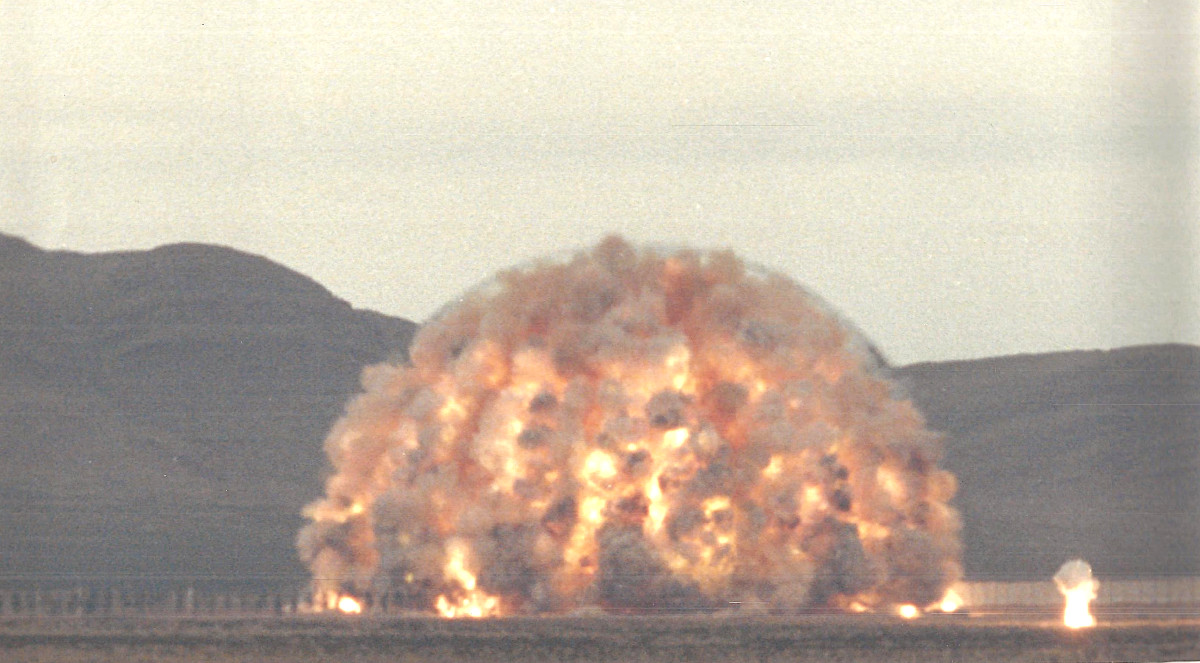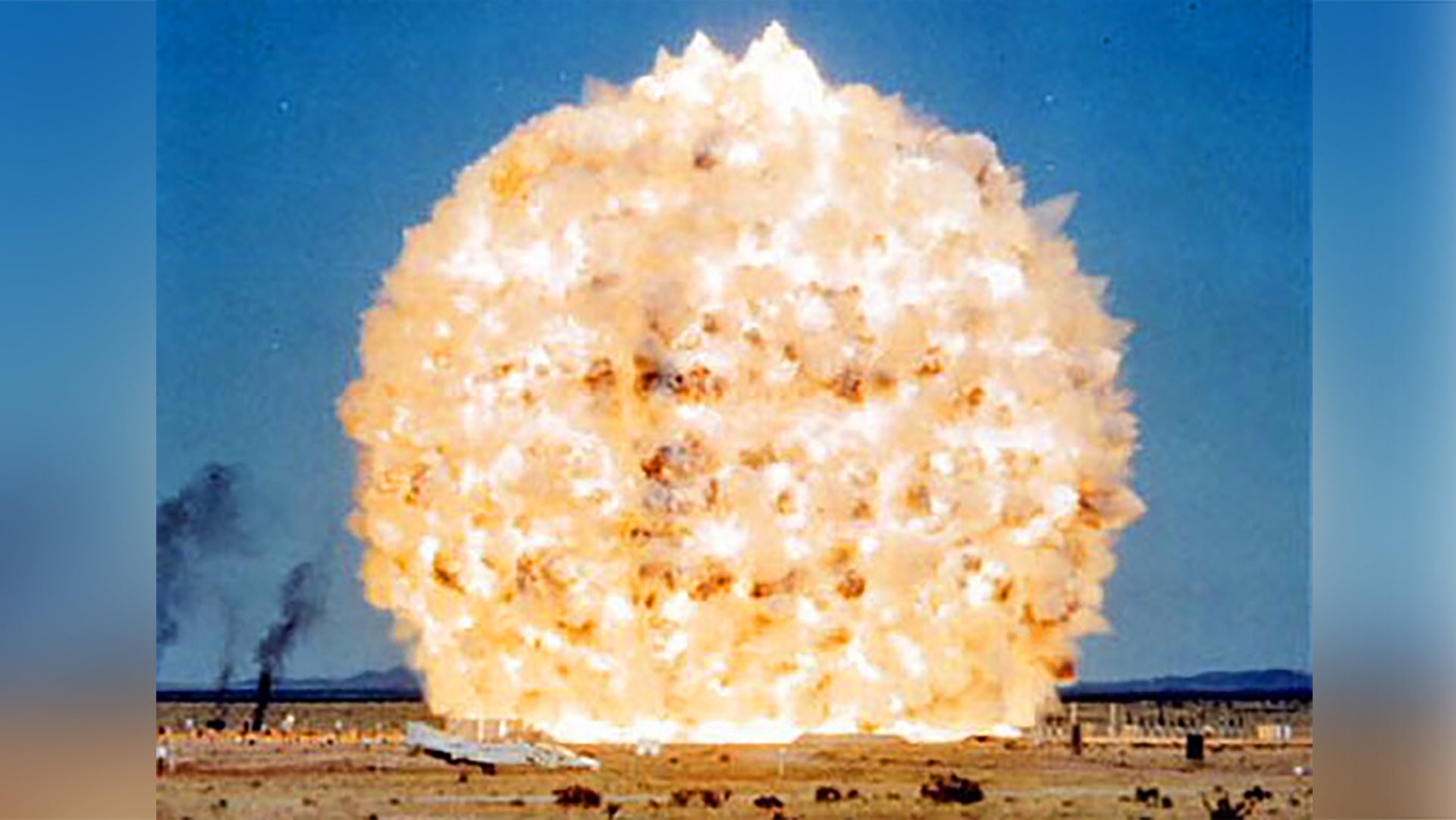The massive explosion at the Port of Beirut in Lebanon yesterday quickly drew comparisons to a nuclear bomb going off, especially due to the huge shockwave and mushroom cloud it produced, despite those being characteristics of any large detonation. In fact, the United States and others have used very large amounts of conventional explosives over the years to simulate the effects of a nuclear weapon without the complexities and environmental concerns associated with actually setting one off.
The largest of these – which was the biggest single deliberate conventional explosive detonation ever – was a test on June 27, 1985, called Minor Scale, that involved detonating 4,744 tons of ammonium nitrate/fuel oil (ANFO) explosive at the Permanent High Explosive Testing Grounds (PHETG), situated within the U.S. Army’s White Sands Missile Range in New Mexico. For comparison, Lebanese authorities say that around 2,750 tons of pelletized ammonium nitrate was a key contributor to the blast in Beirut, which, as Hans Kristensen, the Director of the Nuclear Information Project at the Federation of American Scientists noted, is less than two thirds the basic weight of the explosive pile assembled for Minor Scale.
The Defense Nuclear Agency (DNA), which eventually morphed into the present-day Defense Threat Reduction Agency (DTRA), conducted Minor Scale to gather data on how a nuclear explosion might affect various pieces of military hardware, including the Hard Mobile Launchers for the then-in-development MGM-134A Midgetman intercontinental ballistic missile.
The 4,744 tons of ANFO, placed inside a fiberglass dome and detonated at ground level, produced a blast equivalent to just over four kilotons of TNT. DNA’s intent was to roughly simulate the effects of a nuclear warhead with an eight kiloton yield air-bursting over the target area.
The previous record-holder for largest planned single explosive detonation had been an event nicknamed the “British Bang” in Germany’s Heligoland archipelago in the North Sea, which the U.K. government had gained control of following the end of World War II. Evacuated of its residents during the war and used primarily as a bombing range immediately after, the Royal Navy disposed of approximately 4,000 tons of surplus munitions by blowing them up on one of the islands on April 18, 1947. The force of the blast was roughly equal to 3.2 kilotons of TNT and created a large crater dubbed the Mittelland. The United Kingdom returned the islands to Germany in 1952.

The Minor Scale test was only one of a number of conventional explosions used to simulate nuclear weapons effects that the United States, as well as Canada and Australia, carried out starting the 1950s. These included the Sailor Hat tests that the U.S. Navy executed between November 1964 and June 1965.
The first of these was Sailor Hat Alpha, an underwater detonation in the Pacific Ocean near San Clemente Island off the coast of Southern California, which used a charge that produced the same blast effect as 20 tons of TNT. The remaining three tests all involved explosive piles, each one of which with an approximate yield of 500 tons of TNT, on land at Smuggler Cove on the Hawaiian island of Kahoʻolawe.

After the Minor Scale test, the Defense Nuclear Agency had said it did not intend to carry out any future detonations that would involve a larger explosive pile. “Future tests are not expected to get bigger than Minor Scale,” a 1986 report on the test said. “There are no plans for a test called Major Scale.”
However, this kind of testing did still continue after Minor Scale. Another particularly large Defense Nuclear Agency test, called Misty Picture, took place at the PHETG at White Sands on May 17, 1987. This involved the detonation of 4,685 tons of ANFO and produced a blast equivalent to just under 4 kilotons of TNT.

One of the last planned such explosive tests was one known as Divine Strake, which DTRA, the Defense Nuclear Agency’s successor, planned to carry out in 2006. This was to involve setting off 700 tons of ANFO inside a tunnel at the Department of Energy’s Nevada Test Site ostensibly to help in the development of deep-penetrating conventional weapons to defeat facilities involved in the production and storage of weapons of mass destruction.
The agency insisted that the event was not related in any way to nuclear effects testing, despite the obvious potential value in the development of bunker-busting nuclear weapons, as highlighted in a number of press reports at the time. In 2007, DTRA formally canceled the test in the face of controversy over its intended purpose and concerns that it could launch radioactive dust, leftover from previous nuclear testing at the Nevada Test Site, into the atmosphere.
“I have become convinced that it’s time to look at alternative methods that obviate the need for this type of large-scale test,” then-DTRA Director Dr. James Tegnelia said in a statement on Feb. 22, 2007. “This decision was not based on any technical information that indicates the test would produce harm to workers, the general public, or the environment,” an accompanying DTRA press release said.
No matter what Divine Strake’s actual intended purpose might have been, it, along with Minor Scale and these other tests, all remind us of the immense destructive power that conventional explosives can produce, as was on full display during the recent tragic events in Beirut.
Contact the author: joe@thedrive.com
